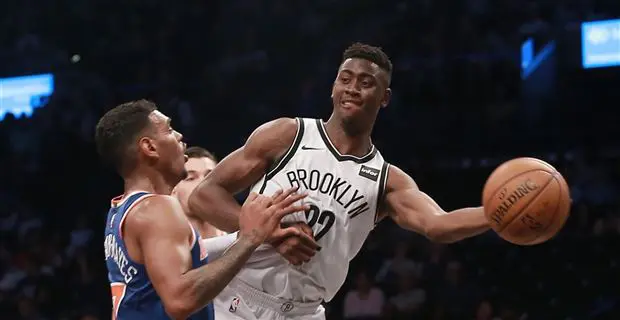After a blistering start to the season, the Brooklyn Nets have cooled off and are 3-6 on the year. There have been a few surprises, like D’Angelo Russell and how he has become the first option with no hiccups; or Rondae Hollis-Jefferson, whose improvement has made him into an incredible two-way player. Unfortunately, not all of these surprises are good, and second-year wing Caris LeVert has gotten off to a slow offensive start.
LeVert has started the last seven games of the young season, and they have been nothing to write home about. Overall, he is averaging 10.6 points, 3.7 rebounds, 3.2 assists and 1.1 steals while boasting a dismal true shooting percentage of 42.8 percent. That last metric is an aggregate percentage that includes two-pointers, three-pointers and free throws, and LeVert has been so dreadful across the board that it hurts my eyes to look at his Basketball Reference page. Frankly, I do not know what the problem is. He was not a reliable outside shooter last year, but at least he was able to slither by the defense and convert on some midrange shots or looks around the rim.
This season, LeVert is shooting 57.6 percent on shots inside of five feet, according to NBA.com. That is down from 65 percent last year. The real issue here is the middle level, where LeVert’s been nearly non-existent. About 10 percent of his looks as a rookie were midrange jumpers, and he converted 48.7 percent of them. That was his spot. He got there because of his ball skills, but his size and length made him even more of a hassle to contain once he got the step. The best case scenario was a player forced LeVert into a contested jumper; the worst case scenario was being Wayne Ellington and having your ankles taken and then auctioned off on eBay.
The results are much different. In nine games, LeVert has attempted 14 midrange shots. He’s made just five. His mechanics are still the same, and a lot of the looks were decent, so it comes down to him being in a slump. Most NBA players experience similar stretches where nothing — literally nothing — falls; even Stephen Curry, the most lethal shooter who has ever lived, has strung together some perplexing shooting performances. The big thing is LeVert continues to stay aggressive when the jumper is not falling. It is amazing how much easier it is to convert jumpers when a player gets some open looks around the rim.
My only concern with a slump is if LeVert’s confidence is negatively affected, then the Nets are going to have some issues.
I am sure Kenny Atkinson and the other coaches and his teammates are in his ear saying it is okay that he is missing shots — because it is. His bad shooting is not detrimental to Brooklyn because he is such a well-rounded player that he will find other ways to make an impact.
The Nets’ offense is more dynamic when LeVert is on the floor with the right pieces, and those are guys who can work away from the ball to get their shot. Even with his poor shooting, Brooklyn has an offensive rating of 108.2 when he is on the court and 109.6 when he sits, according to Basketball Reference. That is a marginal increase. If it were significantly better when he was not on the floor, then there would be some lineup changes. LeVert’s 3.2 assists are almost double what he did last year, and that playmaking ability at his position opened a lot of eyes. Thanks to his slashing and vision, the Nets can find ways to keep him involved.
His dimes are simple — attack the basket and make the right pass. Whether that is a kick out to the perimeter for an open three or a dump pass for an easy layup, LeVert does not try to do too much once he beats the defense. That skill is particularly dangerous when the Nets are running one of their small lineups.
One of Atkinson’s best five-man units places LeVert alongside Trevor Booker, DeMarre Carroll, Allen Crabbe and D’Angelo Russell. In four games, that lineup is plus-nine in 12 minutes. Then, there is LeVert with Carroll, Russell, Timofey Mozgov and Rondae Hollis-Jefferson, and they have played 47 minutes together, the most of any combination. Even with LeVert and his dreadful shooting, they are a minus-three together. (There are also lineups that have been bad when LeVert is out there, but none of them have gotten extended time together. It is not fair to judge a unit that has not had adequate time.)
My thesis is simple — Caris LeVert is fine. The rest of his offense is fine. No matter what, he is going to find a way to be productive while his shooting is lacking. I would be more worried if he were a Kyle Korver-type player who only brings one thing to the table, but that is not the case. LeVert can still attack the glass; he can pass, and he can play defense. Now, if those also begin to deteriorate, we will have to speculate some changes.


